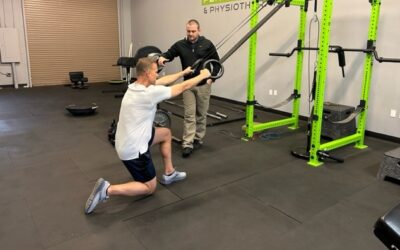Many active adults, especially athletes, come into the clinic when they’ve started experiencing some sort of pain. After all, we are a physical therapy clinic.
This is not abnormal at all.
We go through all of the subjective information to figure out the how, what, when, why, etc. of their injuries.
There is typically a pause after I reveal my findings and a game plan. The pause is due to a little bit of “shock” but you can tell they have something more to say or ask…
When pushed a bit further, the main question they are looking to have answered is… “when can I push through the pain and keep training for (insert your favorite form of activity).”
I wish there was an easy answer to this. That would make this blog so much easier to write.
But, alas, I will try to keep it brief, but still informative, to help you understand when it is safe to push through the pain when training.
Let’s Talk About Pain
First off, we need to start by talking a little bit about what pain actually is.
“Back in the day”, it was heavily believed that our bodies were like machines. You’d take out one human joint and put in an artificial one and expect it to be the same.
This belief assumes our bodies break down and “wear out”. Meaning the more pain you feel, the more injuries you must have underneath that skin of yours. Over the years research has found this to be FALSE.
That thought process is too simplistic for such a complex organism as the human body.
This theory fails to account for the fact that humans can adapt.
The most recent theories for pain, that have been widely accepted in the past decade, are that pain is a complex experience. It is more related to your perceived level of threat and the need to protect whatever it is trying to protect.
And, this may or may not come as a shock, but pain is influenced by a lot of different factors that include things like: sleep, stress, disuse, depression, high fear, etc.
All of these things help provide you with your personal experience of pain.
That is partly why you can give 2 people the same papercut, in the same location, and both will rate their pain differently.
This is why the amount of pain you are feeling isn’t necessarily related to the amount of tissue damage that may have occurred.
I’ve spent time educating people on what pain is because it will help guide you to decide if pushing through an injury and still training is smart.
The answer to the question: should you push through the pain and keep training is…
YES*
*I feel confident telling you yes because the alternative is doing nothing. We now realize that complete rest is not effective and can make the pain even worse.
Training Around Pain: Toss the Ego Out
The first step in training around your pain is finding an entry point.
If you’ve been around exercise long enough, you know there are many different variables you can adjust. Things like the weight you are using, the effort you are giving, sets, reps, tempo, types of exercise you do, etc.
The most common piece of advice I give is to start by reducing your weight and LOSING THE EGO. I’m saying if you normally squat 225 pounds, you may have to back it down to 95 pounds and do reps with that weight since it does not provoke pain.
Next, you can go back to the general 12-15 reps per set and just focus on your tempo with equal parts concentric and eccentric motion.
If those still do not help alleviate the symptoms, you can change the range of motion you use during the exercise, or simply change the exercise all together.
I’ve often found that doing exercises that require both sides of your body at the same time are more challenging because your body will try to off-load the area of pain by shifting away from it. To ensure that your body remains strong on both sides, I prescribe doing more unilateral moves. Unilateral moves help keep your body finely tuned for peak performance while training around pain.
Training Around Pain: Do Not Accelerate Your Progress Too Quickly
The next step (listen carefully) because this may be the most critical part of training through/around pain…DON’T PROGRESS TOO QUICKLY
Typically, when people are training around an injury, they start to experience some small victories. And things are looking good…real good…so they decide to load the bar back up to their normal weights and then a “setback” occurs.
Like everything in life, progress is not linear. Don’t freak out about a slight increase in pain or soreness. Take that as feedback that you did too much and back down a little bit.
If you continue to have pain or can progress well for a week or two, but then develop pain again, it is time to seek out professional help to get you back on track.
This is especially important if it keeps happening. Losing out on training time can be devastating for many factors in your life, i.e. depression, lack of sleep, decreased conditioning, etc.
And nobody likes a grumpy and frumpy Gus.
In summary, training while dealing with pain or an injury is highly encouraged. It must be done intelligently with an understanding of what pain is and what it is trying to tell you. It must be done with patience and consistency.
If you have tried all of that and still have difficulty, I encourage you to reach out for a second opinion on how else you may alter your training to be able to train with the pain present.




